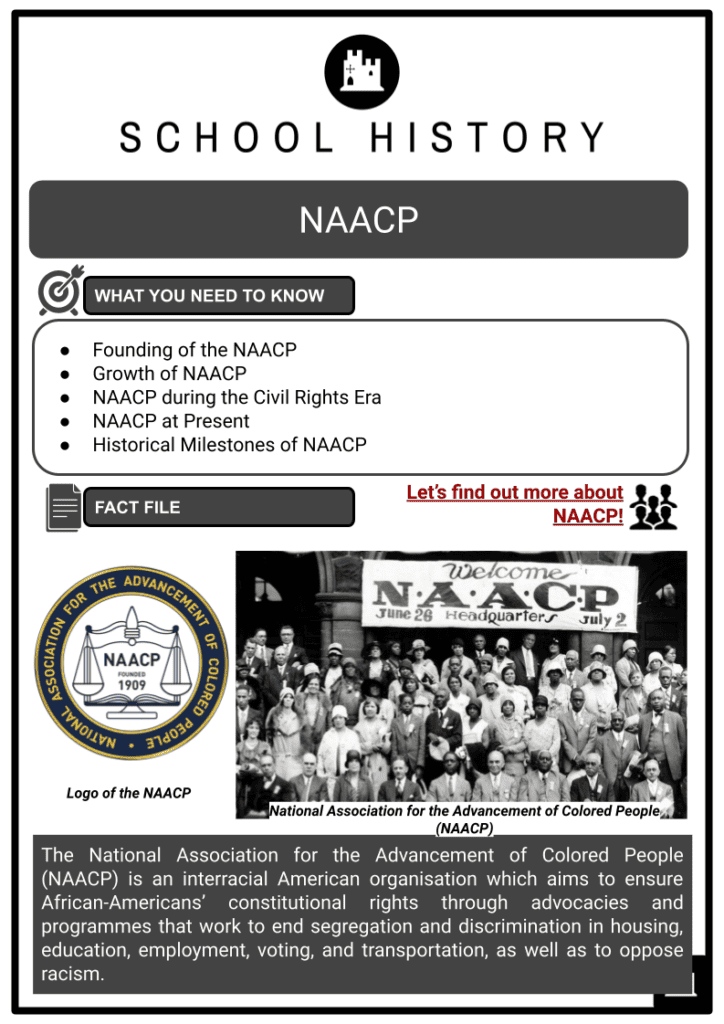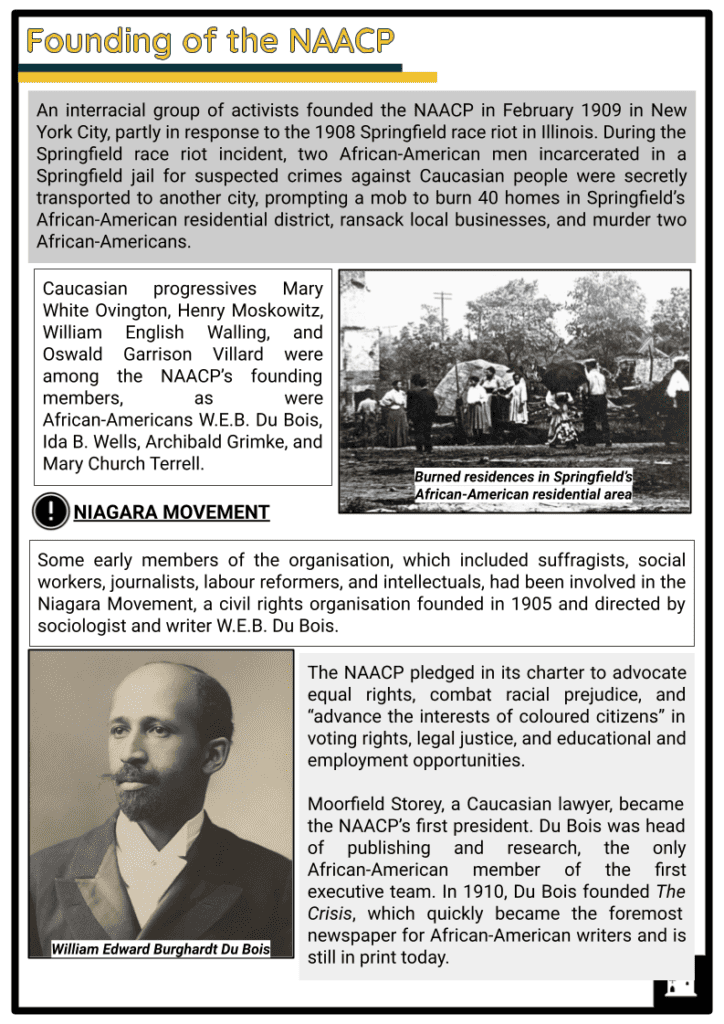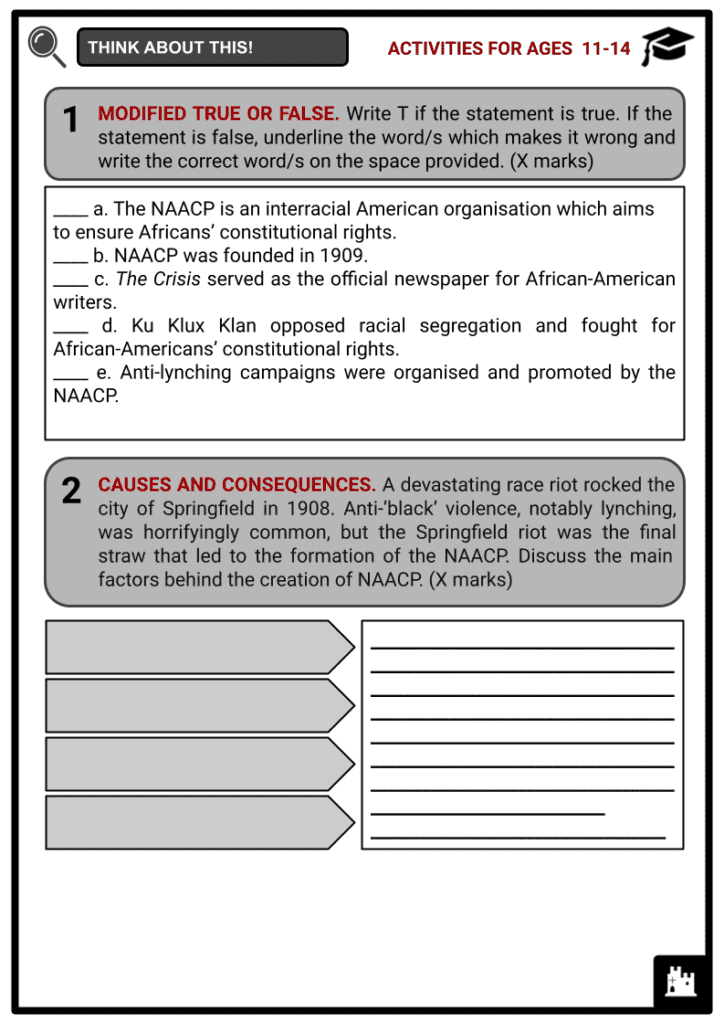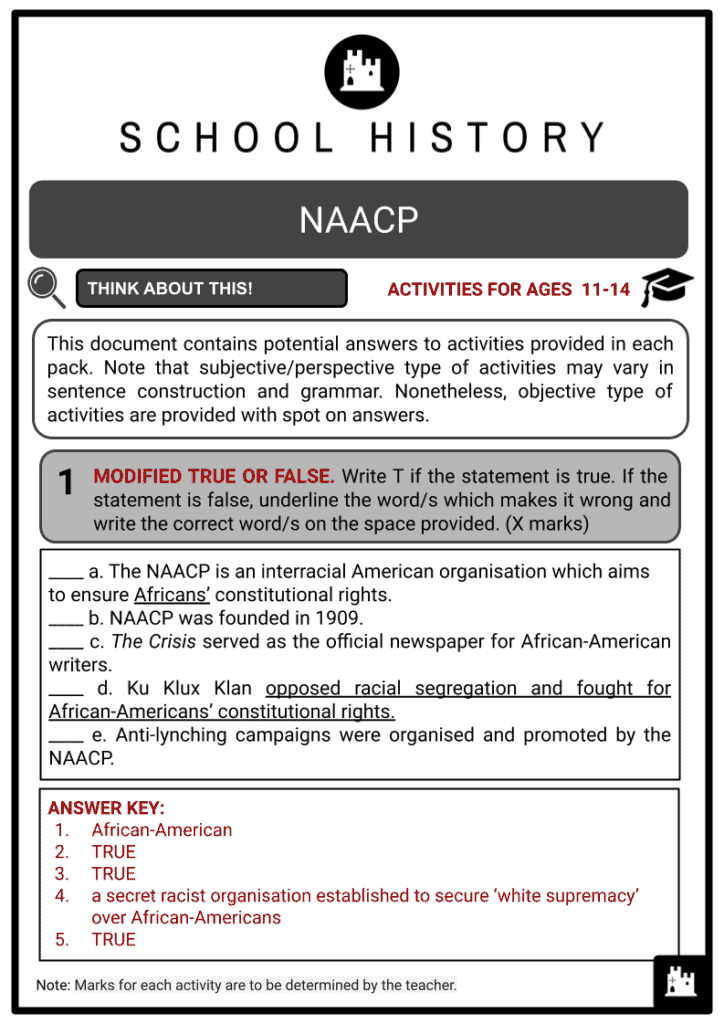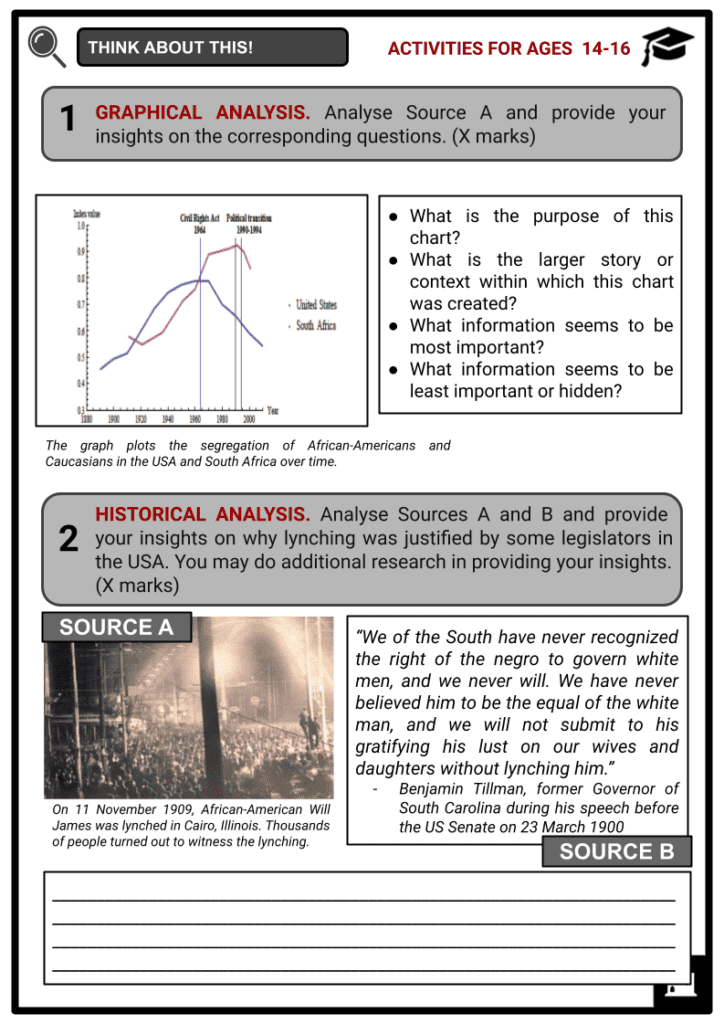NAACP Worksheets
Do you want to save dozens of hours in time? Get your evenings and weekends back? Be able to teach about the NAACP to your students?
Our worksheet bundle includes a fact file and printable worksheets and student activities. Perfect for both the classroom and homeschooling!
Summary
- Founding of the NAACP
- Growth of NAACP
- NAACP during the Civil Rights Era
- NAACP at Present
- Historical Milestones of NAACP
Key Facts And Information
Let’s find out more about NAACP!
The National Association for the Advancement of Colored People (NAACP) is an interracial American organisation which aims to ensure African-Americans’ constitutional rights through advocacies and programmes that work to end segregation and discrimination in housing, education, employment, voting, and transportation, as well as to oppose racism.
Founding of the NAACP
- An interracial group of activists founded the NAACP in February 1909 in New York City, partly in response to the 1908 Springfield race riot in Illinois. During the Springfield race riot incident, two African-American men incarcerated in a Springfield jail for suspected crimes against Caucasian people were secretly transported to another city, prompting a mob to burn 40 homes in Springfield’s African-American residential district, ransack local businesses, and murder two African-Americans.
- Caucasian progressives Mary White Ovington, Henry Moskowitz, William English Walling, and Oswald Garrison Villard were among the NAACP’s founding members, as were African-Americans W.E.B. Du Bois, Ida B. Wells, Archibald Grimke, and Mary Church Terrell.
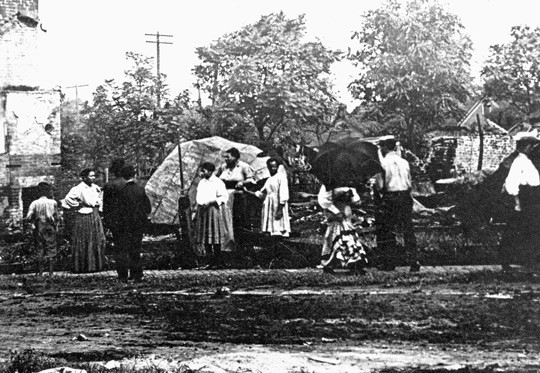
Burned residences in Springfield’s African-American residential area
NIAGARA MOVEMENT
- Some early members of the organisation, which included suffragists, social workers, journalists, labour reformers, and intellectuals, had been involved in the Niagara Movement, a civil rights organisation founded in 1905 and directed by sociologist and writer W.E.B. Du Bois.
- The NAACP pledged in its charter to advocate equal rights, combat racial prejudice, and “advance the interests of coloured citizens” in voting rights, legal justice, and educational and employment opportunities.
- Moorfield Storey, a Caucasian lawyer, became the NAACP’s first president. Du Bois was head of publishing and research, the only African-American member of the first executive team. In 1910, Du Bois founded The Crisis, which quickly became the foremost newspaper for African-American writers and is still in print today.
- In time, The Crisis became a voice of the Harlem Renaissance, as Du Bois published works by Langston Hughes, Countee Cullen and other African-American literary figures.
- The NAACP was widely regarded as a grassroots organisation since it relied on the surrounding community to sell memberships to The Crisis magazine. The publication had a monthly circulation of 1,000 in its first year. It had more than 100,000 readers ten years later, in 1918. It also grew in size, starting at 20 pages and eventually reaching 68 pages, as well as in price, starting at 10 cents per issue and rising to 15 cents.
- To some extent, Du Bois saw The Crisis as his outlet, heavily pushing his own beliefs through the opinion section. Common themes in his writings were presenting a positive, dignified, and progressive image of African-Americans; advocating for action, social justice, and stopping violence against African-American people; and encouraging healthy international relations, particularly about the Pan-African movement.
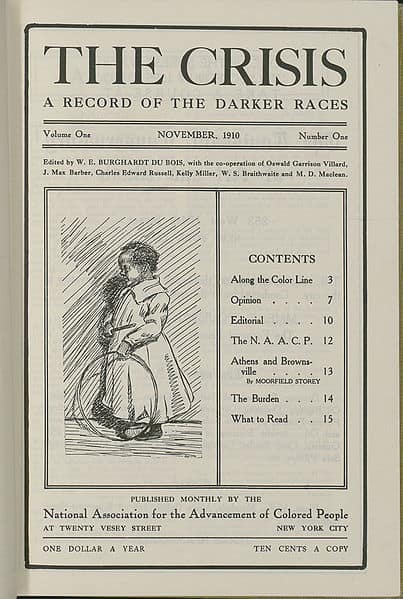
First issue of The Crisis in November 1910
Growth of NAACP
- By 1913, the NAACP had established branch offices in Boston, Massachusetts; Baltimore, Maryland; Kansas City, Missouri; Washington, D.C.; Detroit, Michigan; and St. Louis, Missouri, strongly emphasising local organising.
- Joel Spingarn, a literature professor, one of the NAACP’s founders, devised much of the organisation’s expansion strategy. He was elected NAACP board chairman in 1915 and President from 1929 to 1939.
- A series of early court challenges, notably a victory against a discriminatory Oklahoma legislation that limited voting through a grandfather clause (Guinn v. United States, 1910), helped establish the NAACP’s legal prominence. This “grandfather clause” allowed illiterate Caucasians to avoid taking the literacy test while discriminating against illiterate African-American people, whose ancestors were denied the right to vote despite the Fifteenth Amendment, by requiring them to pass a test. In 1915, the NAACP challenged the law and gained a court win when the US Supreme Court found grandfather clauses unconstitutional.
- Also, in 1915, the NAACP advocated for a boycott of the film Birth of a Nation, which presented the Ku Klux Klan positively while perpetuating racist stereotypes about African-Americans.
- The Ku Klux Klan was a secret racist organisation established to secure ‘white supremacy’ over African-Americans. Established during the Civil War, Klan members were from Southern states who opposed the abolition of slavery. In 1915, the Klan was re-established by Dr William J. Simmons, a Caucasian Protestant who felt threatened by Catholic and Jewish immigrants.
- The 1915 film Birth of a Nation detailing the Civil War, inspired the re-establishment of the Klan. By the mid-1920s, the Klan had grown to 5 million members but gradually declined by the end of 1929. Only WASPS, or ‘White Anglo-Saxon Protestants’, were allowed to be members. Members of the Klan would murder African-American people by beating and hanging them from trees without any trial or compliance with the law. This method became known as the Rope Law, and allegations were often spurious.
- The Klan also encouraged boycotts of businesses that were sympathetic to African-Americans. They would put burning crosses outside the establishments to intimidate them. Houses and churches of African-Americans were bombed or torched. Moreover, those who tried to help them experienced the same violence.
- Institutions such as the NAACP were vital in attempts to combat prejudice and discrimination in the 1920s. Anti-lynching or anti-public killing campaigns were organised and promoted by the NAACP. Even though the efforts failed to get federal funding, the fact that they garnered national attention eventually led to the decline of lynching episodes.
- Membership in the NAACP rose fast, from roughly 9,000 to around 90,000 from 1917 to 1919, with over 300 local branches. In 1920, writer and diplomat James Weldon Johnson became the Association’s first African-American Secretary. In 1934, surgeon Louis T. Wright became the organisation’s first African-American Chairman of the Board of Directors.
- Johnson resigned as Secretary in 1930, and Walter F. White took his place. White was essential not just in his studies on lynching but also in successfully opposing President Herbert Hoover’s nomination of segregationist Judge John J. Parker to the United States Supreme Court.
- White presided over the NAACP’s most fruitful legal advocacy phase. The group commissioned the Margold Report in 1930, laying the foundation for successfully overturning the separate-but-equal doctrine controlling public facilities in 1896. White hired Charles H. Houston as NAACP chief counsel in 1935. Houston was the head of Howard University’s law school, and his strategy on school-segregation issues helped his protégé Thurgood Marshall won Brown V. Board of Education of Topeka case.
NAACP during the Civil Rights Era
- The NAACP was instrumental in the civil rights movement of the 1950s and 1960s. Brown V. Board of Education of Topeka, a 1954 Supreme Court decision that prohibited segregation in public schools, was one of the organisation’s most significant wins.
- Brown V. Board of Education of Topeka was a historic decision by the United States Supreme Court. The Supreme Court found that state laws mandating racial segregation in public schools in the United States are unconstitutional, even if the segregated schools are similar. Brown cleared the door for integration, was a key victory for the civil rights movement, and served as a model for several future impacts litigation cases.
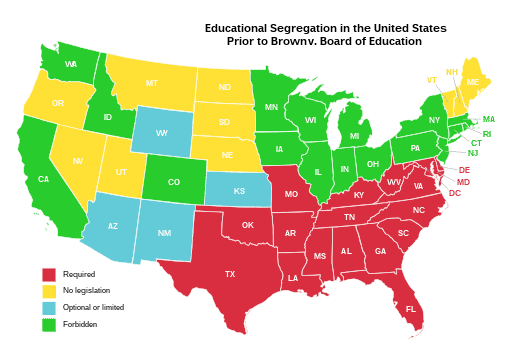
Map showing the educational segregation in the US prior to Brown V. Board of Education of Topeka case - The NAACP also successfully pushed for the enactment of significant laws during this period, including the Civil Rights Act of 1964, which prohibited discrimination based on race, colour, sex, national origin or religion, and the Voting Rights Act of 1965, which prohibited racial discrimination in voting.
NAACP at Present
- At present, the NAACP is concerned with topics such as job inequity, education, health care, the criminal justice system, and the protection of voting rights. The organisation has also advocated removing Confederate flags and statues from public spaces.
NAACP YOUTH COUNCIL
- The NAACP Youth Council is a section of the NAACP in which young people play an active role. In previous years, council members organised under the council’s name to contribute substantially to the Civil Rights Movement. Juanita E. Jackson, the Special Assistant to Walter White and the first NAACP Youth Secretary, founded the Youth and College Division in 1935, and the NAACP National Board of Directors formally established it in March 1936.
OBJECTIVES OF THE NAACP YOUTH COUNCIL
- Providing training in leadership and activism
- Upkeeping of existing Youth Units
- Establishing political and community activism that is proactive
- Public understanding of the importance of youth participation
- Recruiting of youths on new youth units
- To be the pioneers and trailblazers in youth leadership and civil rights education
ACT-SO PROGRAM
- The NAACP has supported the Afro-Academic, Cultural, Technological, and Scientific Olympics (ACT-SO) programme for high school students in the United States since 1978. The programme recognises and rewards African-American adolescents who excel in academics, technology, and the arts. Local chapters host competitions in various categories for grades 9-12 students.
OBJECTIVES OF THE ACT-SO PROGRAM
- To mobilise the adult community in support of academic and after-school excellence.
- Academic performance among adolescents should be recognised as on par with athletic achievement.
- To provide and help students acquire the skills and resources needed to set goals and gain the confidence and training to contribute successfully to society.
Historical Milestones of NAACP
- Between 1920 and 1950, the NAACP focused on many issues such as the anti-lynching legislation, voter participation, employment, due process, and education.
ANTI-LYNCHING MOVEMENT
- The anti-lynching movement was a well-organised political movement in the United States that sought to end the practice of lynching. Lynching was used to suppress African-Americans. In 1916, the NAACP organised a special committee to advocate for anti-lynching laws and to educate the public about lynching.
- Missouri Representative Leonidas Dyer, a Caucasian Republican from Missouri, introduced an anti-lynching measure in Congress in 1918. Dyer, a progressive representing a primarily African-American district, was outraged by the bloodshed from St. Louis racial riots and ongoing lynching across the South. Many rallies were attended by NAACP youth. They took part in numerous anti-lynching demonstrations and wore black in memory of those killed.
LIFT EVERY VOICE AND SING
- Lift Every Voice and Sing is a hymn written in the late nineteenth century by James Weldon Johnson and set to music by his brother, J. Rosamond Johnson. The NAACP designated Lift Every Voice and Sing the “Black National Anthem” in 1919 because of its strength in expressing a cry for liberation and affirmation for African-Americans. James Weldon Johnson was named the NAACP’s first executive secretary the following year.

